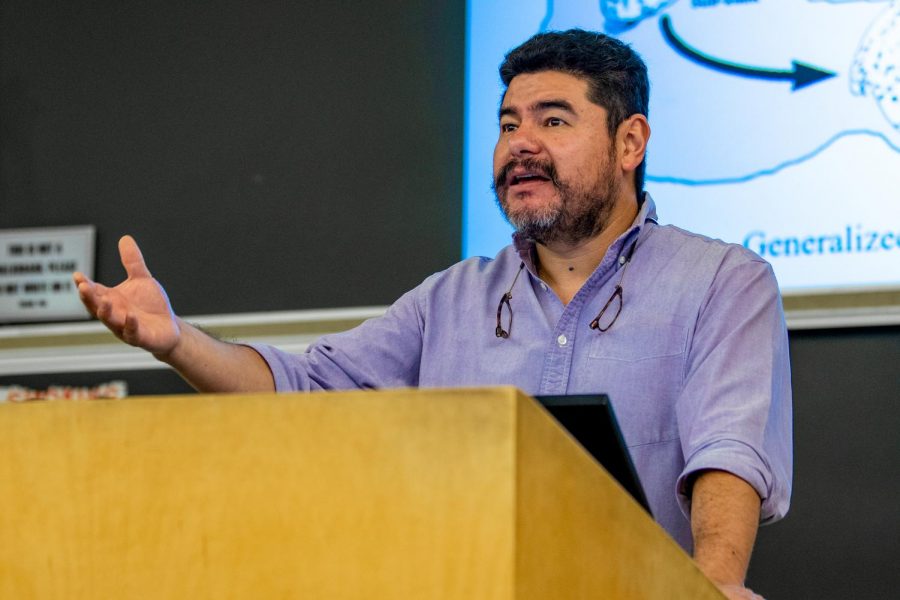Animal Report: SIU graduate students study parasites
Carson VanBuskirk | @carsonvanbDE
Dr. Fransisco Jimenez addresses his class on Wednesday, Sept. 25, 2019, inside Lawson Hall.
October 10, 2019
Two SIU graduate students are researching parasites in mammals and discovering their importance to southern Illinois under the guidance of Dr. Agustín Jiménez, an associate professor in biological sciences at SIU.
Jiménez’s main interest in parasites in mammals is to understand the diversification of fauna, all animals in a region, in the new world.
“I work on parasites of mammals, mainly, and these mammals include animals such as the nine-banded armadillo and the virgina possum,” Jiménez said.
Advertisement
Nine-banded armadillos began to disperse from another continent to North America 20,000 years ago, Jiménez said. He said some would have created an interconnected population.
“That interconnection is going to facilitate the spread of pathogens and parasites,” Jiménez said. “These parasites are eventually going to make it to every population where the armadillos have become established.”
Jiménez’s students, Haitham Alnaqeb and Victoria Phillips, graduate students in biological sciences, are doing their own research as well as writing publications about it.
Alnaqeb is working on research of nematodes, multicellular parasites more commonly known as roundworms, and Phillips is researching ticks and the harmful pathogens they carry.
Haitham Alnaqeb: Research on nematodes
Alnaqeb Nothas been working on a systematic project of nematode belonging to the family Heligmosomoides, a multicellular organism, or a roundworm commonly found in rodents.
“They usually infect small mammals such as voles, mice, squirrels and shrew,” Alnaqeb said. “The main objective is to produce a monograph of Heligmosomoides in North America.”
Advertisement*
The monograph will help create an understanding of the evolutionary relationships and biodiversity of these nematodes in North America in the voles and mice Alnaqeb works with.
To begin the research about one species, Alnaqeb said they have to obtain the specimen from outside and dissect the gut.
“If [parasites] are there, you pick them out and divide them into two groups; the morphological and DNA, molecular, work,” Alnaqeb said.
However, sometimes the specimen is not available outside and must be acquired through a museum that has preserved it, he said.
“I spend a minimum of two weeks on a single nematode, if they are in an ideal condition,” Alnaqeb said. “There are some difficulties on extracting the DNA which make the periods extend to months.”
The reason for such a long extension is due to the fact that the preserved specimens are sometimes not in the best condition, Alnaqeb said, making it much harder to research.
“We don’t have a lot of people classifying nematodes,” Alnaqeb said. “If you look around the world there’s only about six to seven people who’ve been working on this project.”
Alnaqeb said most of the people in the field are older and going to retire soon, so it’s imperative for him to develop these skills. He also said he wants to continue these studies in the future and bring his research to his home country, Saudi Arabia, since no research like this has been done there.
Victoria Phillips: Research on ticks
Phillips’ research, which centers around ticks and the diseases they carry in the southern Illinois area, has been a year long project so far. She said the records of ticks are sporadic and are not consistent.“It’s important to know where the species of ticks are and what we have, because, as I’m sure you’re aware, ticks transmit a lot of diseases,” Phillips said.
“We have Lyme’s Disease, Anaplasmosis, and the list goes on.”
There are 30 sites around southern Illinois where Phillips screens for ticks. She collects them off of vegetation, ID’s them and determines their lifestage. She then screens the different ticks for pathogens.
“Then after that, basically, [we] create a map; a potential risk map of pathogens and coming into contact with these species,” Phillips said.
The way Phillips figures out what kinds of diseases ticks may carry is by looking at little segments of DNA that are unique to the bacteria being carried.
“So, you extract the DNA from the tick, and then you screen it for that one piece of DNA in the bacteria,” Phillips said. “Then you know if it’s present or not.”
She said her goal with this research is to have a clear understanding of what kinds of pathogens people are at risk for in southern Illinois since the records are currently very sporadic.
“The importance is that these pathogens affect our health, and they affect our community, especially when you’re looking at young children and the elderly, they can be at higher risk,” Phillips said.
Staff reporter Elizabeth Biernacki can be reached at [email protected] or on Twitter at @EBiernacki_619.To stay up to date with all your southern Illinois news, follow the Daily Egyptian on Facebook and Twitter.
Advertisement








